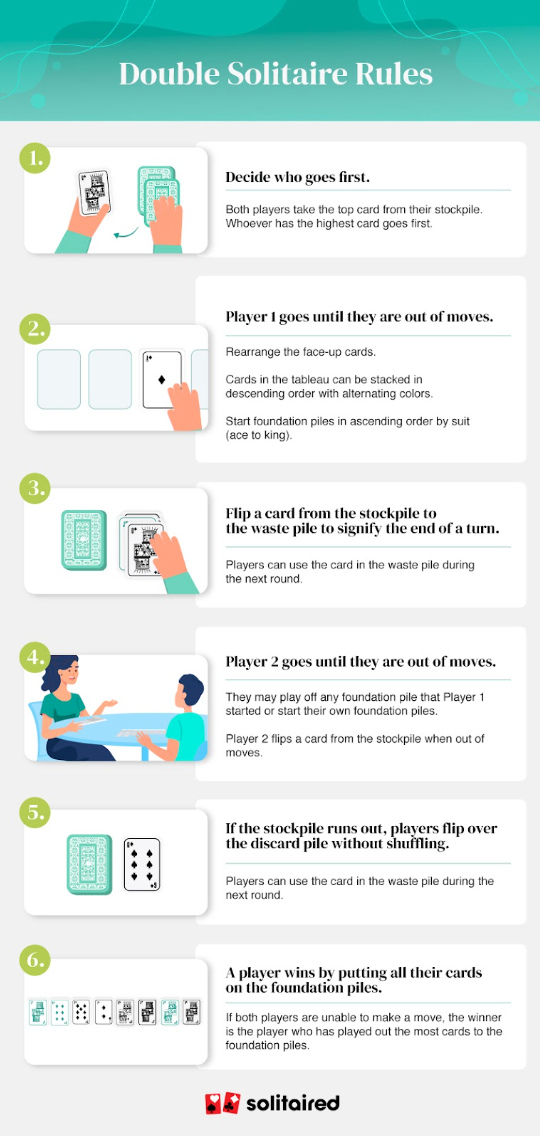How To Play Double Solitaire: Rules and Strategies
By Neal Taparia - 02/15/2023

If you love playing online Solitaire but don’t always love playing alone, give head-to-head Double Solitaire a try! This competitive two-player card game follows the same basic format as the original version, but doubles the fun.
Double Solitaire uses two decks of cards instead of one, and doubles the foundation piles from four to eight, allowing you to play your favorite single-player card game with a friend or family member.
In this guide, we explain how to play Double Solitaire, the rules of gameplay, and winning strategies to consider when playing this fun twist on the classic card game.
Table of contents
Double Solitaire objective
Double Solitaire set-up
Double Solitaire rules
Strategies for Double Solitaire
What is the difference between Solitaire and Double Solitaire?
Want to play Double Solitaire online?
Double Solitaire objective
Like standard Solitaire, the objective of the game is to be the first player to move all of their cards to the foundation piles in the correct order. Unlike standard Solitaire (also called Klondike Solitaire), Double Solitaire uses two card decks to accommodate two players.
Not every game ends with one player playing all their cards. If you get to a point when neither player can make any moves, you can also win Double Klondike Solitaire by playing the most cards to the foundation piles.
Double Solitaire set-up
To play this head-to-head Double Solitaire card game, you’ll need two standard decks of cards and two players. Using decks with different colors or designs helps you keep score and separate the decks at the end of the game.
Here are some terms you may need to know before playing:
Foundation piles: Located at the top of your playing area, foundation piles sit empty at the beginning of the game. You will try to fill them with cards of each suit to win the game.
Tableau pile: Your tableau cards form the columns that you work from during play.
Stockpile: After dealing your tableau, the rest of the deck goes beneath the tableau to form your stockpile.
Waste pile: As you empty the stockpile during play, you create a second pile where you place the cards you don’t use into the waste pile nearby.
After gathering the cards and learning the basic terms, you are ready to set up the game and deal your tableau.

1. Each player deals their tableau
If you know how to play classic Solitaire, you probably have a good idea how to set up Double Solitaire. Both games have similar rules and gameplay, but two-player Double Solitaire requires players to set up their tableau layouts individually.
To begin, each player shuffles their own deck of cards and creates a tableau (or “table”) by laying out seven cards in a row from left to right with the first card face up and the others facedown. Both players must do this.
Repeat the pattern above, starting with the second card from the left. Deal one card face up on the second column and the rest of the seven remaining columns face down. Repeat until you’ve reached the final column, which should have one card face up and six cards face down.
2. Each player places the stockpile next to their tableau
Each player places their remaining cards in a stockpile next to their tableau. You should see two stockpiles: yours and your opponent’s. You both will draw cards from your pile to play onto your tableaus.
3. Leave room for the foundation and waste piles
Leave space on the table for the waste piles and the foundation piles. Since you and your opponent will share the foundation piles, make sure to put them within easy reach of both players. Keep in mind that you won’t have any cards in these piles at the start of the game. As you play, the table will have a total of eight foundation piles in the center, plus a stockpile and a waste pile for each player.
Double Solitaire rules
When playing your cards in Double Solitaire, make sure to follow a few basic rules:
To build your foundation piles, keep the piles separated by suit (spades, clubs, hearts, or diamonds).
When building your foundation piles, add cards in ascending order from ace to king.
When playing cards in your tableaus, build down from the face-up cards in descending order and by alternating colors. For example, on top of a king of clubs (and slightly staggered beneath it), you could place a queen of hearts, followed by a jack of spades.
When you have an empty tableau space, you can only fill it with a king.
You can move columns of cards to other columns on the tableau as long as you follow the rules for descending order and alternating colors.
If you play all the face-up cards from a column and a facedown card remains, you can flip the card over to reveal the card and play it or play cards on it.
1. Decide who goes first
After you and your opponent have finished setting up the game, decide who will go first. You can do this in a variety of ways:
Pick a side and flip a coin. Whoever guessed the correct side of the coin plays first.
Both you and your opponent can take a card from the top of the stockpile. Whoever has the highest card goes first.
2. Player one goes until they are out of moves
As in regular single-player Solitaire, you build down your tableau columns by stacking cards in descending order and opposite color. As you move face-up cards among the tableau columns and reveal facedown cards underneath, turn those cards over and continue to play. You can also move cards from the columns up to the foundation piles, making sure to separate the four piles by suit. If you move all of the cards out of a single column, you can play a king in the empty space.
3. Flip a card from the stockpile to the waste pile to signify the end of a turn
When you have no moves remaining or would like to finish your turn, flip a card from the facedown cards in your stockpile into the waste pile face up to signify that your turn is over. You can use the card in the waste pile during your next round of play.
4. Player two goes until they are out of moves
Player two now takes their turn, playing cards between columns in their tableau or moving them to the foundation piles above. Whenever a player doesn’t have a move, they will flip a card from the stockpile to indicate the turn is over. Gameplay goes back and forth in this fashion until one player runs out of cards or neither player can make a move.
5. If the stockpile runs out, flip over the discard pile
Once you’ve turned over all the cards from your stockpile, you can flip your waste pile to refill your stock. You do not need to shuffle the pile before using it again.
6. Win by putting all your cards on the foundation piles or having the most cards in the foundation piles
The game ends when one player has moved all of their cards to the foundation piles (in the correct order by suit). If neither player has moved all their cards but have no more plays remaining, whichever player has the fewest cards in their stockpile and draw pile wins.
Strategies for Double Solitaire
As with any other card game, you can take advantage of strategies to win Solitaire. The tips below may help you up your Double Solitaire game:
Expose as many facedown cards as possible. To reveal face-up cards in a hurry, you may want to draw from your stockpile before making any other moves. Next, try tackling larger columns before shorter ones to expose more cards.
Play on all eight of the foundation piles. You may be used to only four foundation piles from playing Classic Solitaire, but since Double Klondike uses two decks of cards and double the amount of foundation piles, you have more places to play your cards. Try to keep your eyes on all eight foundation piles as they change rapidly during the course of a game.
Don't empty a tableau spot if you don't have a king. While you may feel a sense of accomplishment by moving all of the cards out, that spot will remain empty without a king to fill it, blocking off an entire column of play.
Don’t move cards for no reason. Just because you can make a move doesn’t mean you have to. For example, placing a card in a foundation pile might make it easier for your opponent to add to that pile or more difficult for you to maneuver cards between your columns.
What is the difference between Solitaire and Double Solitaire?
Double Solitaire has the exact same game rules as the original Solitaire Klondike game. The only difference is that Klondike head-to-head is a kind of simultaneous Solitaire game where two players compete with two decks of cards and eight shared foundation piles.
Want to play Double Solitaire online?
Perhaps you think Double Solitaire sounds fun but don’t have a playing partner or simply want to play on your own. Fortunately, all you need for single-player Double Solitaire is two decks of cards. Just make sure to deal out nine columns instead of seven to make up for the extra cards—the rest remains the same. If you’d like to try this fun and easy game today, check out our online version of Double Klondike Solitaire.
About the author


